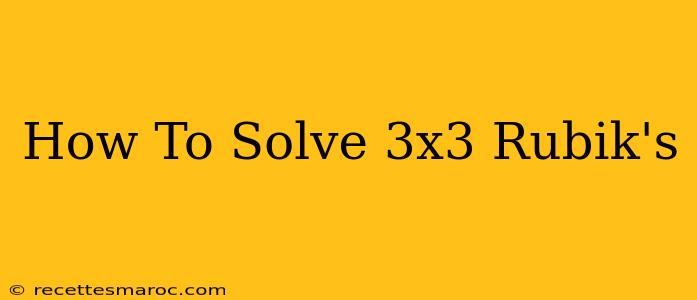So you've got a Rubik's Cube and you're staring at it, completely bewildered? Don't worry, millions have been in your shoes! This guide will walk you through the steps to solving this classic puzzle, breaking it down into manageable chunks. We'll focus on a beginner-friendly method, perfect for those just starting their cubing journey.
Understanding the Method: Layer by Layer
The method we'll use is a layer-by-layer approach. This means we'll solve the cube one layer at a time, building upon each completed section. This is a methodical approach that's easier to learn and remember than more advanced techniques.
Stage 1: The White Cross
The first step is to create a white cross on the top face (we'll call this the "white face"). This involves positioning the four white edge pieces correctly, so they form a plus sign (+) with the white center. Don't worry about the orientation of the edges yet – just get them in the right spots! There's no single algorithm (a sequence of moves) for this; use intuition and common sense. Simply rotate the edges to place them correctly.
Stage 2: Completing the White Layer
Now that you have the white cross, it's time to complete the first layer. This involves placing the four corner pieces so that they complete the white layer. This step requires learning a few simple algorithms. There are variations, but a common approach involves using algorithms to bring the correct corner piece to the correct position and orient it simultaneously. Practice these algorithms until they become second nature.
Example Algorithm (may need to be adjusted depending on the cube's orientation):
- R U R' U' (This represents a right turn, up turn, right inverse, and up inverse.)
- R = Rotate the right face 90 degrees clockwise
- U = Rotate the top face 90 degrees clockwise
- ' = Inverse (counter-clockwise rotation)
Stage 3: The Middle Layer
This stage involves solving the middle layer without disturbing the completed white layer. This is done by inserting the four edge pieces into their correct positions. Again, algorithms are key here. Focus on bringing the correct edge pieces to the correct slots. The algorithms are generally shorter than those used in the first layer, making this a relatively quick step.
Stage 4: The Yellow Cross
Now we tackle the yellow face. The goal is to create a yellow cross on the top face. There are algorithms designed specifically for this, but sometimes you can achieve this by intuitive moves. A key goal is forming a yellow cross, even if it's not perfectly oriented.
Stage 5: Orienting the Yellow Edges
With the yellow cross complete, this step involves orienting the yellow edges. If the yellow cross is already oriented correctly, you can skip this step. You will need another algorithm to achieve this.
Stage 6: Permuting the Yellow Corners
This step involves placing the yellow corner pieces into their correct positions. An algorithm is needed here to cycle through the corners to place them correctly.
Stage 7: Orienting the Yellow Corners
Finally, this step involves orienting the yellow corners to complete the cube. A final algorithm will be necessary to finish the solve.
Tips for Success
- Practice: The key to mastering the Rubik's Cube is consistent practice. Start slow, focusing on accuracy over speed.
- Learn the Notation: Familiarize yourself with standard Rubik's Cube notation. This will make learning and following algorithms much easier.
- Use Resources: There are countless videos and tutorials available online. Find one that suits your learning style.
- Be Patient: Solving a Rubik's Cube takes time and effort. Don't get discouraged if you don't get it right away.
Solving a Rubik's Cube is a rewarding experience. With patience and persistence, you'll be amazed at how quickly you can improve. So grab your cube, follow these steps, and get ready to experience the satisfaction of a solved puzzle!

